We often get asked, "What's the difference between FOX and RockShox forks?" It's a common question when shopping for a mountain bike, and the answer isn't straightforward.
We can't definitively answer whether one fork manufacturer is “better” than the other (sorry). Instead, this guide aims to explore the basics about their fork line-ups, the technology they use, what features their forks offer, and a bit of history. It will also consider World Cup race results and the brands' popularity among our customers.
[button]Shop Suspension Forks[/button]
FOX vs. RockShox Suspension Fork Highlights
- RockShox broke ground with one of the first production MTB suspension forks in 1989. Fox produced its first mountain bike suspension fork in 2001.
- Both Fox and RockShox offer a range of suspension forks from lightweight XC race forks to long-travel downhill forks.
- Race results: Both are used by the best racers in the world. In recent years, RockShox has been slightly more successful in World Cup XC racing, while Fox has been slightly more successful in World Cup DH racing.
- TPC sales: We tend to sell slightly more Fox fork-equipped bikes than RockShox bikes.
Fox and RockShox Fork Hierarchies:
 |
 |
|
| Entry-level | Rhythm, Performance | Select |
| Mid-level | Performance Elite | Select+ |
| High-end | Factory | Ultimate |
Overview of key FOX and RockShox forks:
| Intended use |  |
 |
| Cross-country | 32 Step-Cast, 34 Step-Cast | SID SL, SID, Reba, Recon |
| Trail | 34 | Pike, Revelation, 35 |
| Enduro | 36, 38 | Lyrik, Yari, Zeb, Domain |
| Downhill | 40 | BoXXer |
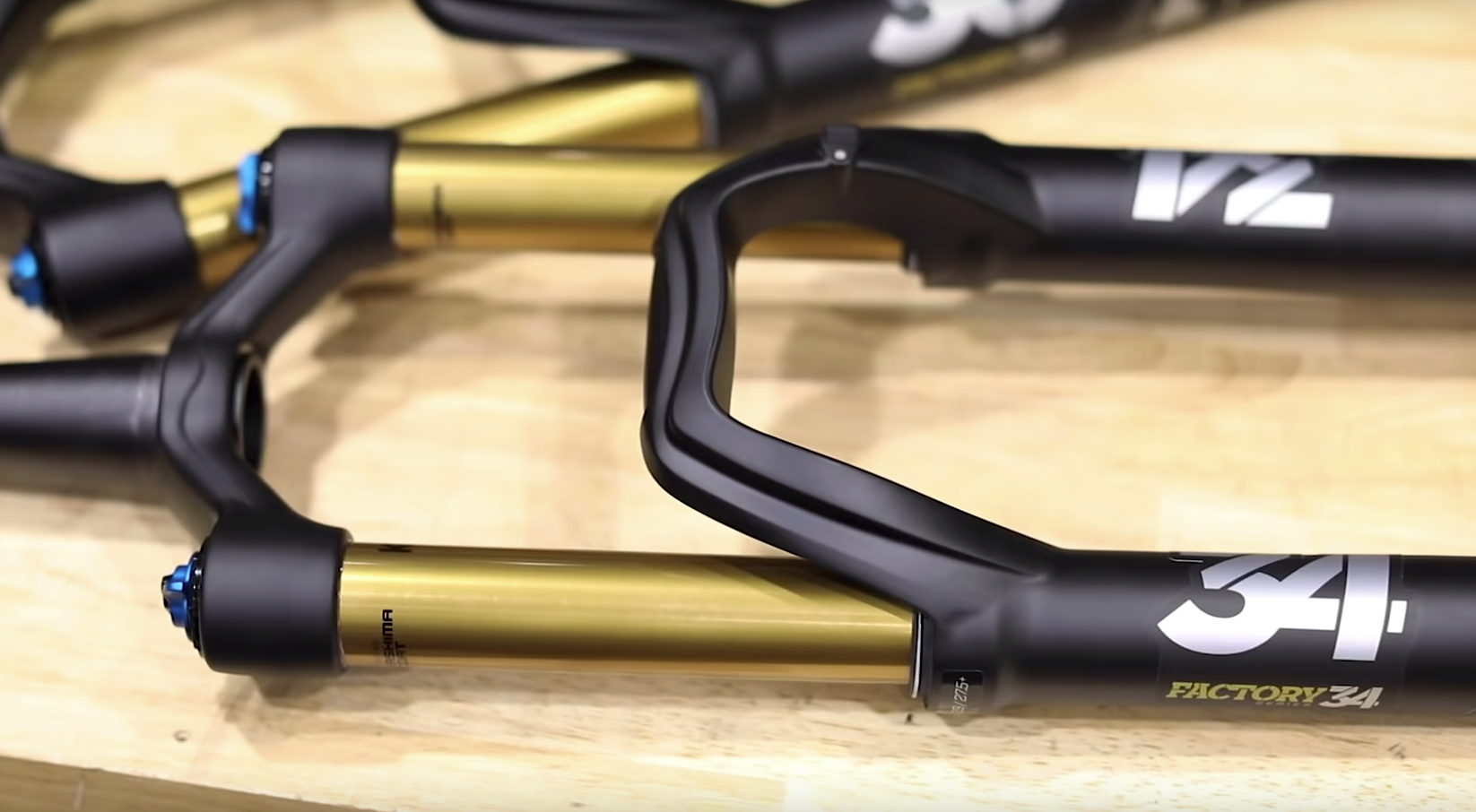 (Note: the information in this guide will apply to recent model year bikes and forks. Older products may have different specifications.)
(Note: the information in this guide will apply to recent model year bikes and forks. Older products may have different specifications.)
Okay, ready for a deep dive on mountain bike forks?
The vast majority of mountain bikes made by major brands will come equipped with a FOX or RockShox fork from the list above. These forks offer suspension travel anywhere from 100mm to 200mm (measured in 10mm increments) depending on a fork's intended use:
- XC: 100-120mm
- Trail: 120-150mm
- Enduro: 150-180mm
- Downhill: 180-200mm
With few exceptions, most forks are available in 27.5" and 29" wheel versions. The sections below will explain other specific features in greater detail.
RockShox, in particular, does make a large amount of budget forks (more than what was listed in the table above) that we won't focus on. To keep things simple, we'll focus on the most common forks offered on the modern mountain bikes in our inventory, which tend to be more performance oriented and can retail for $1,500+ when new.
[button]Shop Suspension Forks[/button]
Contents
- FOX MTB forks
- RockShox MTB forks
- Fork performance hierarchy
- Dampers
- Stanchion coatings
- Stanchion diameter
- Signature colors
- Service intervals
- History
- World Cup race results
- Popularity
- Final thoughts
[button]Shop Mountain Bikes[/button]
FOX MTB forks
FOX fork models are named based on stanchion diameter. Forks are available in Rhythm, Performance, Performance Elite, and Factory trims (see the FOX Performance Hierarchy). Rhythm and Performance level forks use the FIT GRIP damper. Performance Elite and Factory level forks use the FIT4 or FIT GRIP2 dampers. (See FOX Dampers).
To learn more details about specific models, check out our dedicated Fox Fork Buyer's Guide.
FOX 32
The FOX 32 is FOX’s standard XC fork. It uses 32mm stanchions to keep weight low. Travel: 100-120mm
FOX 32 Step-Cast
The 32 Step-Cast fork is lighter than the standard FOX 32. It has narrower lowers and a notable “step” at the bottom of the lowers to reduce material and weight. Travel: 100mm
The FOX 34 is FOX’s trail fork. It is one of the most popular trail forks on the market. It uses 34mm stanchions. In terms of weight and stiffness, it splits the difference between the FOX 32 and the FOX 36. Travel: 120-140mm
[product-block handle="fox-34-factory-29-130mm-15x110mm-fork-44mm-offset-2023-black-fit4"/]
FOX 34 Step-Cast
The 34 Step-Cast is lighter than the standard FOX 34. It uses a notable “step” at the bottom of the lowers to reduce material and weight. It is comparable in weight to many XC forks but is stiffer due to the 34mm stanchions. Travel: 100-120mm
[product-block handle="fox-2022-34-k-float-sc-29in-f-s-100-fit4-remote-adj-psh-lk-3pos-10pm-cp-shiny-orange-black-clear-logo-kabolt-110-blk-1-5-t-44mm-rake-shiny-blk-am"/]
FOX 36
The FOX 36 is FOX’s trail/enduro fork. It uses 36mm stanchions for greater stiffness. Travel: 150-160mm
[product-block handle="fox-36-factory-29-160mm-fork-15qrx110mm-51mm-offset-2023-shiny-black-grip2"/]
FOX 38
Introduced in 2021, the FOX 38 is a long travel single-crown fork for enduro applications. It thicker 38mm stanchions and a new elliptical inner shape to the steerer tube to increase stiffness. Travel: 160-180mm
[product-block handle="fox-38-factory-29-180mm-fork-15qrx110mm-44mm-offset-2023-shiny-black-grip2"/]
FOX 40
The FOX 40 is FOX’s dual crown downhill fork. It uses 40mm stanchions for maximum stiffness. Travel: 180-200mm
[button]Shop FOX[/button]
RockShox MTB forks
For cross country, trail and enduro forks, RockShox offers both a high-end and entry-level option to suit different rider needs and budgets. The main difference is the damper (see RockShox dampers). Cross country forks are available in RL, RLC, Select, Select+, and Ultimate trims. Trail and enduro forks are available in RC, RCT2, RC2, Select, Select+, and Ultimate trims. (See the RockShox Performance Hierarchy.)
To learn more details about specific models, check out our dedicated RockShox Fork Buyer's Guide.
RockShox SID
The SID is RockShox’s high-end lightweight XC fork. In 2021, RockShox released the SID SL and the SID Ultimate. The SID SL is for pure XC with a new crown, steerer, stanchions, and chassis optimized for lighter weight with only 100mm of travel. The SID Ultimate uses stiffer 35mm stanchions and has 120mm of travel. It is designed to be a lightweight trail fork for light trail and aggressive XC. Travel: 100-120mm
RockShox Reba
The Reba is RockShox’s entry-level XC fork. It has 32mm stanchions and prioritizes light weight. Travel: 100-120mm
[newsletter]
RockShox RS-1
The RS1 is an “upside-down” XC fork. This means the stanchions are at the bottom, which is opposite most single-crown forks. In theory, this can increase stiffness where the fork mounts to the bike, the point of highest leverage. The RS1 is named after RockShox’s first production fork. It has a full carbon chassis and steerer. It requires a front wheel with a proprietary RS1 specific “Predictive Steering” front hub. Travel: 100-120mm
RockShox Pike
The Pike is RockShox’s high-end trail fork. It uses 35mm stanchions for increased stiffness. Travel: 120-140mm
[product-block handle="rockshox-pike-ultimate-29-fork-15x110mm-44mm-2022"/]
RockShox Revelation
The Revelation is RockShox’s entry-level trail fork. It uses 35mm stanchions for increased stiffness, but reduces cost compared to the Pike with a cheaper damper. Travel: 120-160mm
RockShox Lyrik
The Lyrik is RockShox’s high-end enduro fork. It uses 35mm stanchions like the Pike, but the stanchion walls are thicker to provide greater stiffness. Travel: 140-160mm
RockShox Yari
The Yari is RockShox’s entry-level enduro fork. It uses the same 35mm stanchion chassis used by the previous generation Lyrik but reduces cost with a cheaper damper. Travel: 150-180mm
[product-block handle="rockshox-yari-rc-27-5-160mm-fork-15x110mm-42mm-offset-2"/]
RockShox ZEB
An answer to Fox's 38, the ZEB is a long-travel single-crown enduro fork with thicker and stiffer 38mm stanchions. Travel: 150-190mm
[product-block handle="rockshox-zeb-select"/]
RockShox BoXXer
The BoXXer is RockShox’s dual crown downhill fork. It uses 35mm stanchions, but the most recent model has been updated with thicker 38mm stanchions Travel: 180-200mm
RockShox Bluto
The Bluto is RockShox's fat bike specific fork. It’s based on the 32mm stanchion Reba chassis but widened to accommodate 26" fat bike tires up to 4.8” wide. Travel: 80-120mm
Note: RockShox offers other budget-oriented forks (e.g., 30, Recon, Sektor, Judy) not described in this list. They are less common in our inventory so they have been omitted.
[button]Shop RockShox[/button]
FOX vs. RockShox Fork Performance Hierarchy
Both FOX and RockShox have various fork trims and use specific naming conventions to denote the performance these trims offer. Higher-end forks will cost more, but they generally offer lighter weight and/or better damper performance (see more about dampers).
FOX Fork Trim Levels
The trim of FOX forks accompanies the model name to describe its performance level. E.g., the FOX 34 can come as a FOX 34 Rhythm, FOX 34 Performance, FOX 34 Performance Elite, or a FOX 34 Factory.
Entry Level: Rhythm
FOX Rhythm forks are original equipment (OEM) forks that only come on complete bikes and are generally not available to be purchased aftermarket. Rhythm forks use a FIT GRIP damper that is slightly less adjustable and less complicated. The lower legs are cast from aluminum to keep costs down.
Entry-Mid Level: Performance
Performance forks use a FIT GRIP damper. The cast lowers are magnesium, the same construction as the higher end forks.
Mid-High End: Performance Elite
Performance Elite forks use higher-end FIT4 or FIT GRIP 2 dampers. Performance Elite is functionally the same as Factory forks but the stanchions use a black finish instead of the gold Kashima coat used on Factory forks.
High-End: Factory
Factory is the highest level of FOX fork and it is priced accordingly. All models use higher-end FIT4 or FIT GRIP 2 dampers. Factory forks are recognizable due to the distinctive gold Kashima coating on the stanchions to reduce friction and increase wear life. Factory forks are also available in FOX special signature orange color.
RockShox Fork Trim Levels
RockShox forks are offered in various trims within high-end and entry-level models. E.g., a RockShox Pike will be available as a Pike RC, Pike RCT3, Pike Select, Pike Select+, or Pike Ultimate.
For 2020 suspension products, RockShox has simplified its naming conventions. New forks are classified as Select, Select+, and Ultimate. Older forks are designated RC/RL or RCT3/RLC, which relates to their damping systems.
Entry Level: RC / RL / Select
RC forks are generally trail- or enduro-focused. They are OEM forks that only come on complete bikes and are generally not available to be purchased aftermarket. They come with external rebound and low-speed compression adjustment.
RL forks are generally cross-country-focused and offer rebound damping adjustment plus an open or lock compression setting that can be controlled by an optional remote.
Newer Select level forks will feature Charger RC or Charger RL dampers.
Mid-High Level: RCT3 / RLC / Select+
RCT3 forks are generally trail- or enduro-focused. They use the Charger 2 damper with a three-position lock-pedal-open compression adjust lever with low-speed compression adjustment in the open mode.
RLC are generally cross country focused. They add low-speed compression adjustment to the lockout and rebound adjustments.
Newer Select+ level Lyrik and Pike forks use the new Charger 2.1 damper.
High-End: Ultimate
Ultimate is RockShox’s newest top-end option using the new Charger 2.1 damper, as well as new low friction SKF seals and Maxima damping fluid to decrease stiction. Ultimate forks come in either an RCT3 or RLC version with the same adjustments described above, or a new RC2 version with high and low-speed compression damping adjustment as well as rebound. Ultimate forks are also available in various RockShox signature colors.
High-End: SID Ultimate Carbon / World Cup
The SID is the only model available in Ultimate Carbon (formerly called World Cup) trim. It is the premier cross-country fork in the SID range. It uses the same damper as the SID Ultimate/RLC but uses a carbon fiber crown to further reduce weight.
[button]Shop Suspension Forks[/button]
FOX vs. RockShox Fork Dampers
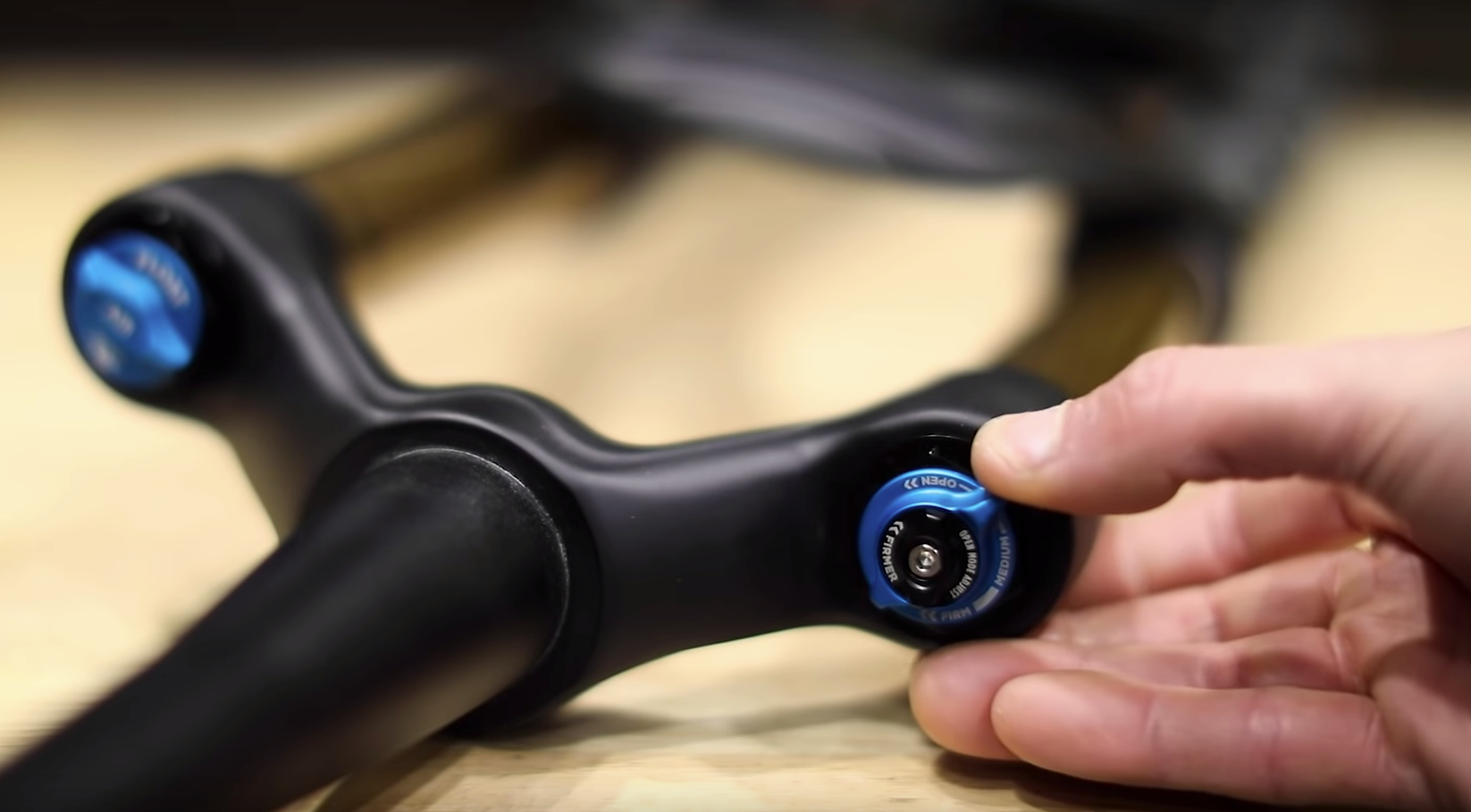 The damper lives in the right fork leg of FOX and RockShox forks. Here, oil and valving controls the speed and behavior of the fork as it compresses and extends. As described in the Performance Hierarchy, different forks use different dampers depending on their trim. All dampers listed below are adjustable to suit rider preferences and terrain.
The damper lives in the right fork leg of FOX and RockShox forks. Here, oil and valving controls the speed and behavior of the fork as it compresses and extends. As described in the Performance Hierarchy, different forks use different dampers depending on their trim. All dampers listed below are adjustable to suit rider preferences and terrain.

FIT stands for "Fox Isolated Technology." Here's how the different Fox dampers compare:
| Damper | Rebound damping | Compression damping |
| FIT GRIP | One adjustment | Lock-out lever |
| FIT4 | One adjustment | Three-position lever and low-speed adjust knob |
| FIT GRIP2 | High- and low-speed | High- and low-speed |
| Live Valve | Electronically controlled | Electronically controlled |
FIT GRIP
The GRIP damper is fitted to more affordable models in the FOX fork range. It has a compression damping adjustment lever on the top cap. It’s based on FIT4 technology, but instead of a bladder, the damper cartridge uses a spring-loaded IFP (Internal Floating Piston) to prevent the mixing of air and oil. It is a simpler design than the FIT4, and it’s a bit heavier.
FIT4
FIT4 is one of FOX's premium cartridge dampers. It has a three-position compression adjust lever on the top cap with a climb, trail, and open (descend) mode. Low-speed compression can be fine-tuned in the open mode with a black knob in the center of the top cap lever. There is also a two-position remote lockout version available that uses a remote to switch between a climb and open mode. It uses a sealed design with a rubber bladder to compensate for displaced oil as the damper cycles through the travel.
FIT GRIP2
This is the damper used on FOX’s newest gravity forks (FOX 36 / FOX 40 / FOX 49). It’s similar in design to the entry-level FIT GRIP damper but it has much more adjustment. It offers high- and low-speed compression damping adjustment and independent high and low-speed rebound damping adjustment. It uses an IFP instead of a bladder but also has more advanced valve technology and various friction-reducing treatments not seen in the standard GRIP damper.
Live Valve
FOX Live Valve is an electronically controlled suspension system. It uses ultra-fast reacting sensors to automatically control and adjust the fork and shock. Sensors are strategically placed on the frame and wheels and they allow a Live Valve Controller to process data from the terrain to constantly adjust the suspension for maximum efficiency and control. Live Valve's default is closed — the equivalent of you running your shock and fork in the climb mode. The Controller only opens the suspension during an impact, and then switches back to firm after impact. Live Valve is currently only available on a few select, high-end mountain bikes.

Here's a quick reference guide to compare RockShox's damping platforms:
| Damper | Rebound damping | Compression damping |
| Motion Control | One adjustment | Lockout lever |
| Charger RC/RL | One adjustment | Low-speed or remote lockout |
| Charger 2 RC/RL/Select | One adjustment | Low-speed or remote lockout |
| Charger 2 RCT3/RLC/Select+ | One adjustment | Three-position lever or remote lockout; low-speed |
| Charger 2 & 2.1 RC2 | One adjustment | High- and low-speed |
| Charger 3 RC2 | One adjustment | High- and low-speed |
Motion Control
Motion Control is an entry/mid-level damper that comes with either a compression adjustment lever on the top cap or a remote lockout. Motion Control is an emulsion damper, which means the damping oil isn't separated from the air in the fork by an IFP or bladder. This is simpler and less expensive to produce. It functions well, but it can lead to less precisely controlled damping under more extreme use.
Charger RC / RL
Charger RC / RL is a version of the Charger damper that RockShox describes as 'cartridge-style' rather than a fully sealed cartridge damper. It is intended to split the difference between the Motion Control and Charger 2 damper, offering Charger damper technology in a more affordable package. It has adjustable rebound and adjustable low-speed compression (RC) or a remote lockout (RL).
Charger 2 RC2
Charger 2 is RockShox’s high-end damper. It's a fully sealed cartridge damper unit that uses a bladder to keep the damping oil isolated from the air. It's available in different versions depending on the application.
RC/RL/Select Charger 2 dampers have adjustable rebound and adjustable low-speed compression (RC) or a remote lockout (RL).
RCT3/RLC/Select+ Charger 2 dampers use a three-position compression adjuster with lock, pedal, and open modes (RCT3) or a remote lockout that uses a remote to switch between a lock and open mode (RLC). Low-speed compression can be fine-tuned in the open mode with a black knob in the center of the top cap lever.
RC2 Charger 2 dampers have adjustable high and low-speed compression damping plus rebound. This is only used on gravity-oriented forks (ZEB, Lyrik, Pike, and BoXXer).
Charger 2.1 RC2
This is an updated version of the Charger 2 damper found on Ultimate forks and Select+ ZEB, Lyrik, and Pike forks. It changes some of the Charger 2 valving so there is less high-speed compression damping and more low-speed compression damping to make the fork ride higher in its travel and improve downhill performance.
It uses a new piston wear band inside the damper to manage oil flow better and a new rod seal from SKF to reduce friction by over 30% at the rebound shaft.
It is available in RCT3 and RC2 versions, with the same adjusters as the regular Charger 2 range.
Charger 3 RC2
Charger 3 is RockShox's latest and greatest downhill-oriented damper found on the newest generation Pike, Lyrik, ZEB, and BoXXer. It's a departure from the previous Charge 2/2.1 designs. Instead of a rubber bladder, the Charger3 design uses a coil sprung internal floating piston (IFP).
The Charger 3 is designed to be quieter and more consistent regardless of heat build up on long, rough descents, and elevation and pressure changes.
Another big benefit is that the low-speed damping has no effect on the high-speed damping, and vice versa. RockShox eliminated "cross talk" between the two systems, so you can set your low-speed and high-speed compression adjusters how you see fit without one circuit impeding the performance of the other.
[button]Shop Mountain Bikes[/button]
FOX vs. RockShox Fork Stanchion Coatings
 Kashima coat (left) / Fast Black with sag gradients on inside of left stanchion (right)
Kashima coat (left) / Fast Black with sag gradients on inside of left stanchion (right)
Fork stanchions are generally coated using some form of anodizing surface treatment. Stanchion coatings lubricate the stanchions and seals to reduce fork stiction and provide a hard scratch-resistance surface to prevent damage.
FOX Factory forks use a distinctive gold coating on the stanchions called a Kashima Coating. Kashima is a hard-anodized surface treatment created by Miyaka Company of Japan. It uses lubricating molybdenum disulfide deposited via electrical induction into the billions of micropores on the surface of hard-anodized aluminum for better lubrication and less abrasion and wear.
Many will select factory level forks simply because they enjoy the aesthetics of the gold Kashima coat. All other non-Factory FOX forks currently use a standard black stanchion coating. It is debatable whether Kashima actually improves fork feel or performance enough to be noticeable to the average rider.
All RockShox forks use a black stanchion coating called Fast Black. RockShox Stanchions also have sag gradients printed directly on the stanchions. This is unique to RockShox forks. These sag gradients make it quick and easy to determine sag without using a measuring tool like a ruler.
FOX vs. RockShox Fork Stanchion Diameter
In general, more cross country-oriented forks use narrower diameter stanchions to reduce weight. Most cross country forks use stanchions that are 32mm in diameter. More enduro oriented forks use thicker diameter stanchions that are 35-36mm in diameter to increase stiffness which improves performance in rough terrain. Trail oriented forks try to compromise between weight and stiffness. Most trail focused forks use stanchions that are 34-35mm in diameter.
FOX names its forks based on stanchion diameter (e.g., FOX 32 is a 32mm stanchion cross country fork), so it is easy to discern each FOX fork’s stanchion diameter and intended use. For RockShox forks, refer to the RockShox suspension fork list to determine what diameter stanchions specific fork models use.
FOX vs. RockShox Fork Signature Colors
 Shiny Orange (left) / Gloss Silver (center) / BoXXer Red (right)
Shiny Orange (left) / Gloss Silver (center) / BoXXer Red (right)
Most forks come with black lowers but FOX and RockShox currently offer unique signature colors so riders can personalize the look of their bikes.
FOX’s signature color is called Shiney Orange. It is only available for Factory-level forks. There have also been several limited release "Heritage" colors for the 36, 38, and 40 that are highly desirable: Pistachio, Root Beer, and White.
RockShox currently offers SID Blue for the SID Ultimate, Gloss Silver for the Pike Ultimate, Heavy Meadow Green for the Lyrik Ultimate, Slab Grey for the ZEB Ultimate, and BoXXer Red for the BoXXer Ultimate. Older models may have slightly different color options (e.g., Fluorescent Yellow and BoXXer Red for previous SID and Lyrik models).
FOX vs. RockShox Fork Service Intervals
FOX only has one service interval for its products: after 125 hours of riding or annually, whichever comes first.
RockShox recommends lower leg service on forks after a maximum of 50 hours of riding. It recommends damper and spring service for most modern forks after 200 hours maximum.
[button]Shop Suspension Forks[/button]
FOX vs. RockShox History
FOX Factory, Inc.
FOX came from the world of moto suspension. In the 1970s, long-travel suspension was revolutionizing the motocross industry, but the technology for achieving it was still developing. FOX's founder, Bob Fox, was an amateur motocross racer and a mechanical engineer. He saw a golden opportunity to enter the market. In 1974, he opened a small business distributing suspension components.
Bob Fox had a particular interest in designing an air spring shock that would help prevent bottom-outs and make adjusting spring rates easier. Drawings for his prototype ‘FOX AirShox’ shock were done by hand and he built the first shock in a friend’s garage using a mill and a manual lathe. After a year of development, the first production run of the FOX AirShox was ready in 1975. Fox sold 200 shocks that year.
Racers using the new FOX AirShox went on to win the AMA 500cc National Motocross Championship in 1976 and 1977. After these back to back championships, sales exploded to over 10,000 units and FOX was firmly established as a premier suspension company in the motocross world. FOX Factory, Inc. (often referred to in the industry as ‘Fox Racing Shox’) was incorporated in 1978.
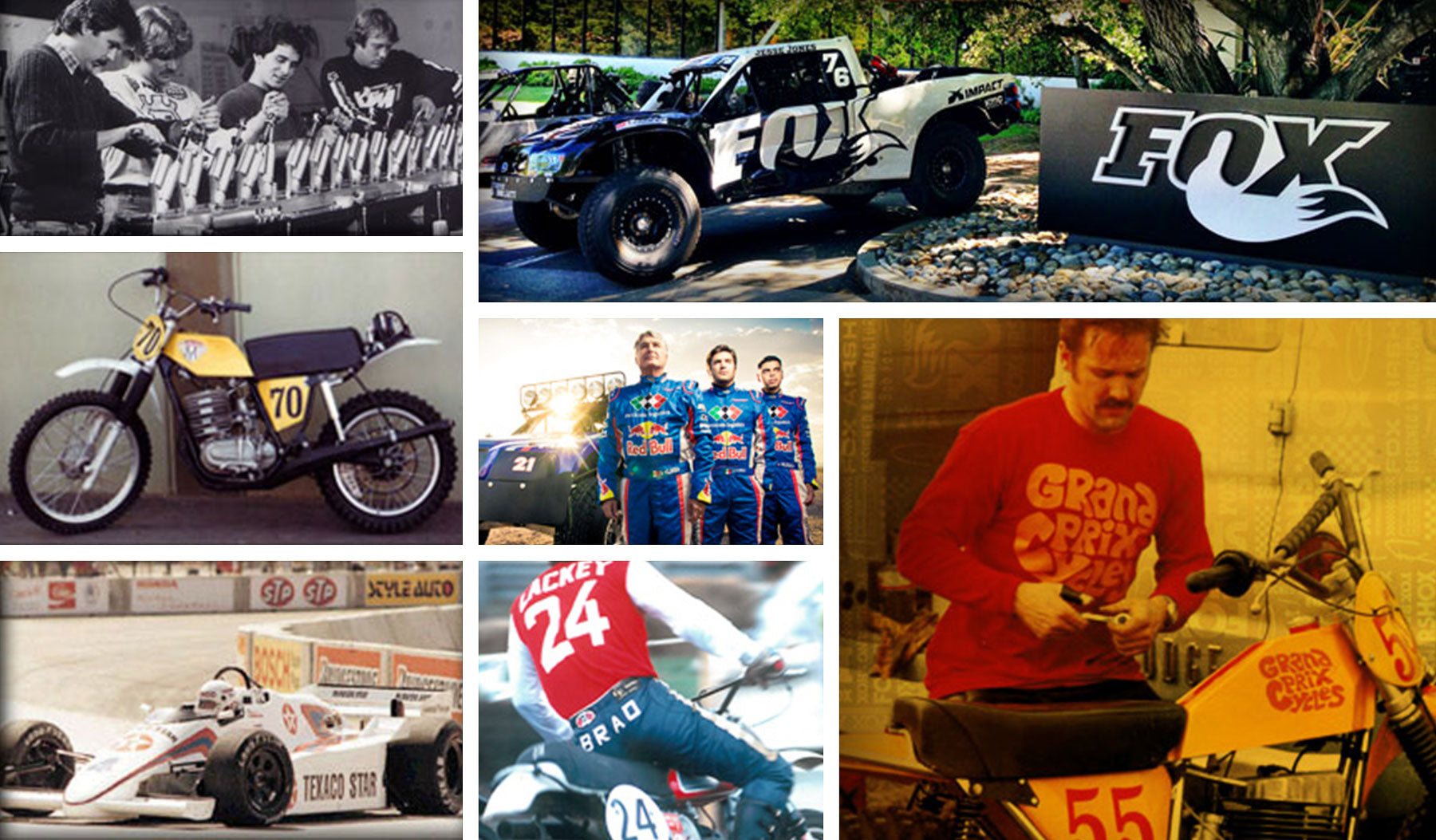 The FOX AirShox (top left) and founder Bob Fox (bottom right) | Photos courtesy Fox Factory, Inc.
The FOX AirShox (top left) and founder Bob Fox (bottom right) | Photos courtesy Fox Factory, Inc.
Over the years, FOX has diversified into various other high-performance sports, including off-road racing trucks, road racing cars, road racing motorcycles, and snowmobiles. FOX made its first bicycle shock prototype in 1991 and entered the mountain bike market in 1992 with an original equipment manufacturer (OEM) rear shock produced for Cannondale. OEM partnerships with Specialized and Trek followed soon after.
FOX arrived relatively late to the mountain bike fork market and didn’t produce its first suspension fork until 2001. However, this first fork was immediately innovative due to its stiffer 32mm stanchions (other forks at the time were no larger than 30mm). This added rigidity came at the right time. Like motocross in the 1970s, mountain biking was beginning to go through its own long-travel suspension revolution and FOX was at the forefront.
Fox Tail vs. Fox Head
Many mountain bikers may be unaware that FOX (suspension) and Fox (apparel) are different companies. There's a reason the two brands have the same name. Bob Fox, founder of Fox Factory, Inc. (suspension) and Geoff Fox, founder of Fox Head Inc. (apparel) are brothers and both have a history of racing and developing motocross suspension and equipment. They were involved in each other’s businesses in the early years but eventually incorporated separately.
To differentiate between the two brands many will refer to Fox Factory, Inc. the suspension company as Fox Racing Shox or more colloquially, “Fox Tail,” and Fox Head Inc. the action sports apparel company as Fox Racing or “Fox Head.” Products are easy to differentiate by logos which use a foxtail (suspension) and a fox head (apparel).
RockShox Inc.
Like Fox, RockShox founder, Paul Turner got his start with motorcycles, which he raced as a teenager in the 1970s. By the time he was 18, he had started his own company selling aftermarket motorcycle engine parts. Turner quickly advanced to working as a factory mechanic for Honda’s pro motocross team and as a consultant for Honda R&D. He began racing triathlons and mountain bikes after moving to Northern California to work with Honda.
 Paul Turner with an early RockShox RS-1
Paul Turner with an early RockShox RS-1
As a motocross rider, Turner was accustomed to plush suspension. Rigid mountain bikes felt harsh and archaic in comparison. He began working on a simple, modified, lightweight motorcycle fork which evolved into the first generation of RockShox products. In 1987, with the help of Keith Bontrager, Turner created a prototype mountain bike with front and rear suspension for an industry trade show.
The other half of Rockshox, Stephen Simons, was an entrepreneur and also a veteran motorcycle racer. In 1974, Simons worked for Moto-X Fox (Geoff Fox's company which originally distributed the FOX AirShox) with Bob and Geoff Fox, and he was involved in the design and testing of the first FOX AirShox. Simons went on to found his own company, Simons Inc., developing suspension modifications and front forks.
After building his first prototype, Paul Turner began building his suspension components in his garage using Simons Inc. parts. In 1989, Turner approached Stephen Simons to lend his manufacturing expertise to a bicycle suspension idea that became the genesis of the RockShox brand. Simons became the president of the new company that year.
 Herbold's Championship-winning Miyata with an early RockShox fork.
Herbold's Championship-winning Miyata with an early RockShox fork.
The next two years were highly successful for RockShox. Turner brought Greg Herbold aboard as a RockShox test rider and company spokesperson. At the inaugural UCI Mountain Bike World Championships in 1990, Herbold became the first downhill world champion on a bike equipped with one of the first RockShox suspension forks and Ned Overend became the first Cross-Country World Champion riding a Specialized-branded RockShox fork. That same year, RockShox released its first production suspension fork called the RS-1.
The world's second-largest component company, SRAM, acquired RockShox in 2002. RockShox is currently part of SRAM Corporation.
FOX vs. RockShox World Cup Race Results
The UCI World Cup is the pinnacle of cross country (XC) and downhill (DH) mountain bike racing. The best riders in the world compete aboard the best gear. FOX and RockShox provide equipment and support for several professional riders and teams competing in these two disciplines. This is where suspension manufacturers develop their technology and prove out their designs.
The charts below show the win rate of fork manufacturers in the XC and DH disciplines over the last five years. It takes into account both the men’s and women’s fields and includes world championship races. Five years is far back enough to be relevant to most buyers looking at purchasing mountain bikes today.

XC World Cup wins show that RockShox has been the dominant XC fork manufacturer, winning 54% of races over the last five years. The RockShox SID has been one of the top XC forks since its inception in 1998. It also has the benefit of being the fork equipped on the Specialized Epic, one of the most successful XC race bikes of the modern era. RockShox has been a strong force in top-level XC racing since its first World Championship in 1990 with Ned Overend.
It is interesting to note that DT Swiss, whose suspension products are uncommon in the U.S., has a higher win rate than FOX. That this can largely be attributed to three riders — Nino Schurter, Yana Belomoina, Jolanda Neff. Nino Schurter is one of the most successful XC racers of all time and has scored numerous wins, World Championships, World Cup overalls, and Olympic Gold while using DT Swiss suspension. He and his team switched to RockShox in 2017 and he has contributed several wins and championships for RockShox as well. Yana Belomoina and Jolanda Neff won several races on DT Swiss forks on the way to their respective 2017 and 2018 World Cup overall wins.
DH World Cup wins show that FOX has been the dominant DH fork manufacturer, winning 68.2% of races over the last five years. FOX provides a large amount of factory support for many successful downhill racers and teams. Two of their most notable riders are Rachel Atherton and Aaron Gwin. Rachel Atherton has six World Cup overalls, and five World Championships, and Aaron Gwin has five World Cup overall wins. FOX also supports Greg Minaar, the male downhill racer with the most wins ever.
Recent wins for RockShox and Ohlins have largely come from two dominant young French riders — Amaury Pierron and Loic Bruni. They are the respective winners of the 2018 and 2019 DH World Cup overalls, and Loic Bruni has won four World Championships in the last five years. They will likely increase the win rates for their respective fork brands in future races.
This data also only accounts for wins and does not factor in podiums or any other results to create a more detailed and nuanced picture. This data also omits Enduro World Series results, another top-level race series.
For the average rider, pro racing may have little application to their everyday riding. Pros are exceptionally fast and skilled and they are able to push equipment much harder than most riders. Mountain biking is a sport where equipment matters, but riders make the biggest difference in results. Ultimately, the data here should not be taken as definitive evidence that any manufacturer is superior to another. But professional racing does show how products perform at the absolute limit, which can be powerful for influencing fans and inspiring brand loyalty. It is not uncommon for particular brands to enjoy popularity or become desirable due to the success of pro riders.
[button]Shop Mountain Bikes[/button]
FOX vs. RockShox Fork Popularity
Because TPC is the world leader in buying and selling used bikes, we have substantial data about what bikes are popular and what suspension forks they are equipped with. I dug into our sales for the last 12 months and looked at thousands of different bikes to analyze how FOX and RockShox are performing.
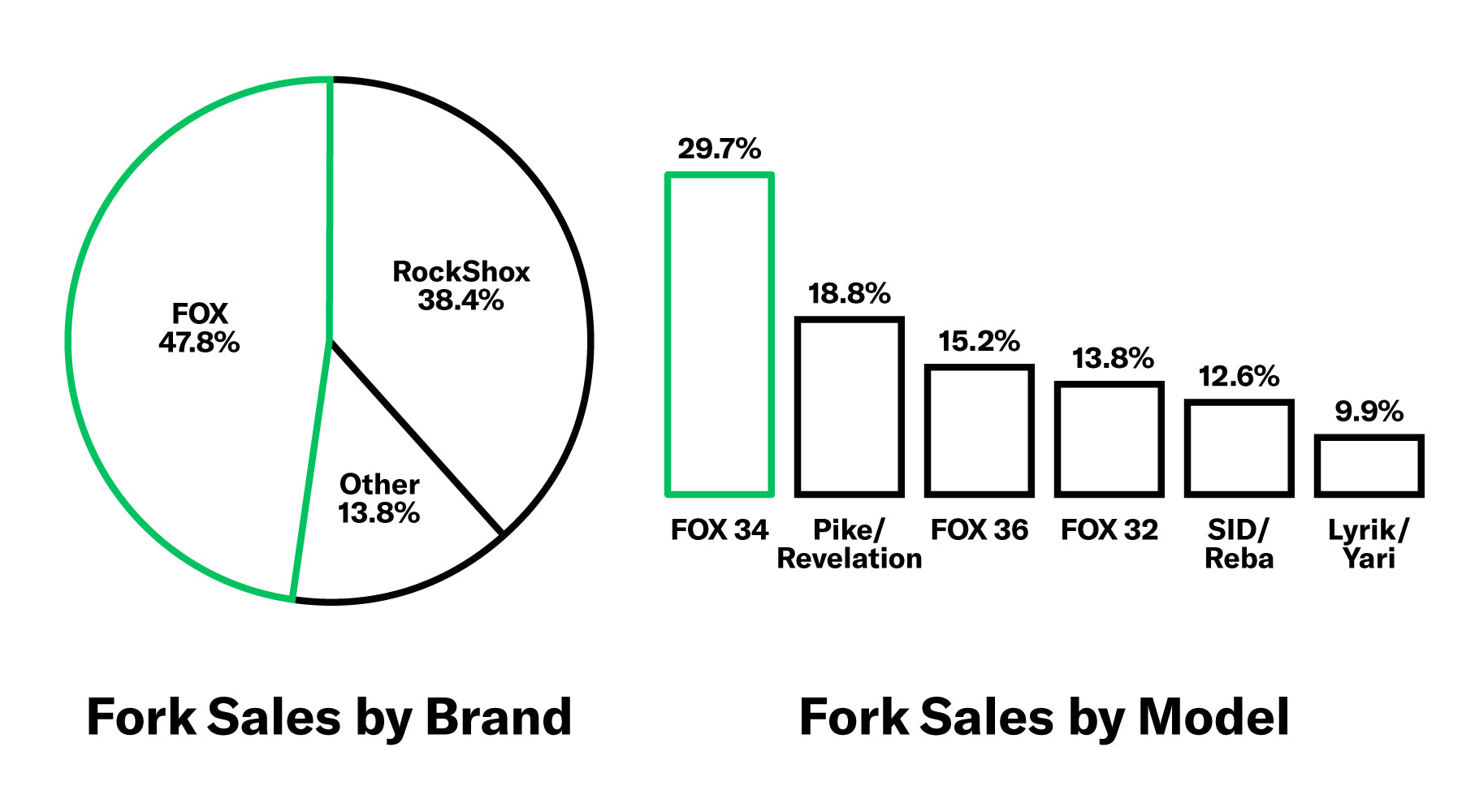 The data presented above does not indicate that one brand is "better." It simply shows how bike manufacturers and owners have chosen to equip their bikes over the last few years.
The data presented above does not indicate that one brand is "better." It simply shows how bike manufacturers and owners have chosen to equip their bikes over the last few years.
Forks sales by brand shows that we sell more bikes equipped with FOX forks, but the margin isn't exceptional at 9.4%. What we have seen over several years is that FOX and RockShox popularity is relatively even. It will fluctuate slightly, with one pulling ahead of the other from time to time but it will often flip-flop between the two.
It's clear that FOX and RockShox are dominant. The vast majority of other fork brands are only equipped on less than 1% of bikes we sell. The only standouts among this group are Cannondale and Suntour. The Cannondale Lefty has a small cult following and makes up 3.4% of fork sales, while Suntour has carved out a small market share with 2.4% of fork sales.
Fork sales by model examine how the most popular forks compare to each other and it shows that the FOX 34 is the most popular mountain bike fork by an overwhelming margin. It enjoys over 10% more sales than RockShox's trail forks, the Pike and Revelation. This also tells us that the trail bike category is by far our best-selling mountain bike category. FOX's enduro offering, the FOX 36, follows in third place. XC forks like the FOX 32, SID, and Reba enjoy fewer sales than trail forks. FOX and RockShox are fairly even in the XC category with the FOX 32 outselling the SID and Reba by only 1.2%
(Note: For Fork Sales by Model, certain RockShox models have been combined based on their intended use. This is because FOX offers a wide range of performance specs for the same model based on trim equivalent to the range RockShox covers using two separate models. E.g., a FOX 34 Rhythm is comparable to a RockShox Revelation RC while a FOX 34 Factory is comparable to a RockShox Pike Ultimate.)
[button]Shop Suspension Forks[/button]
Final Thoughts
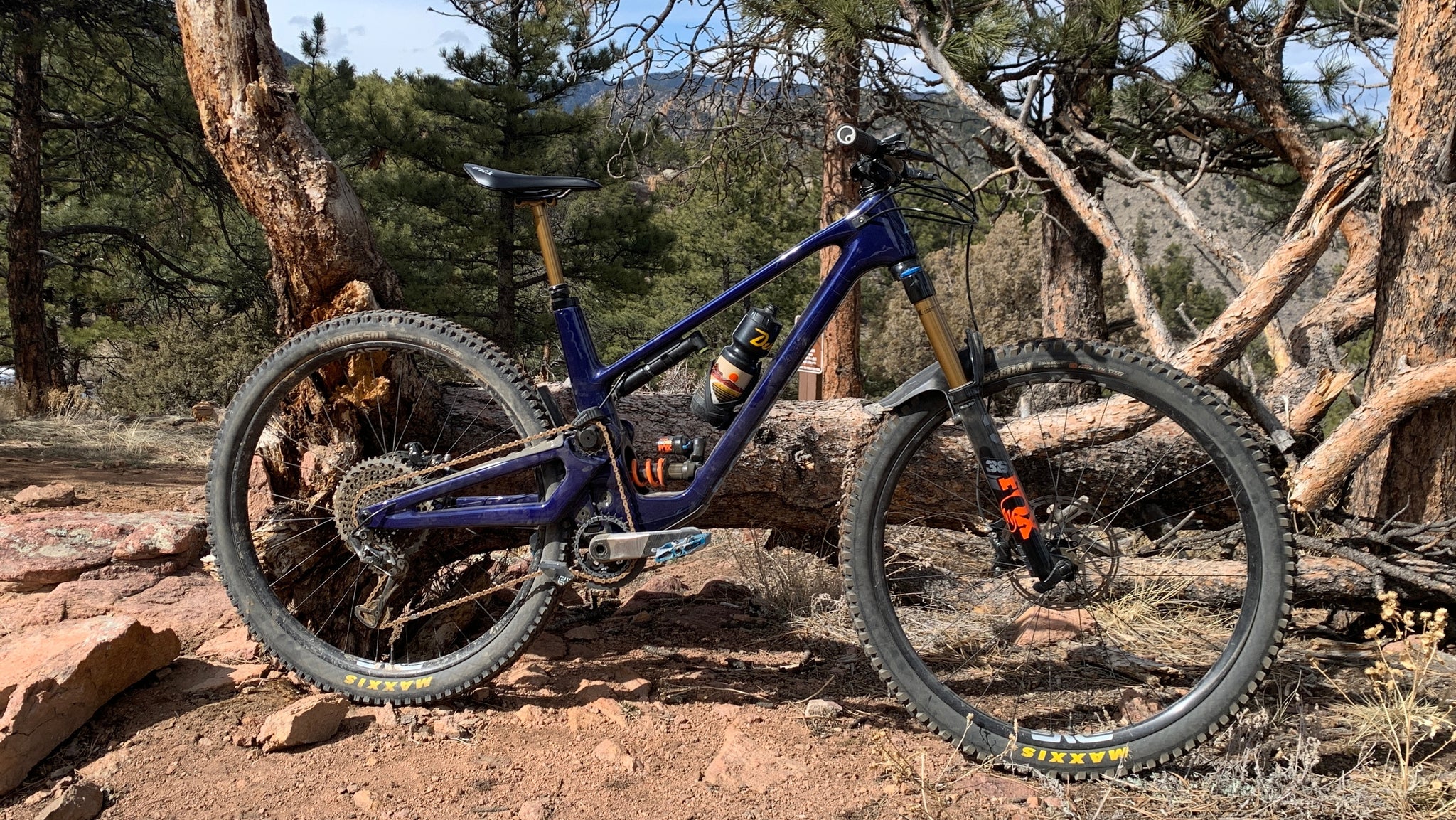 My current bike.
My current bike.
Both FOX and RockShox make quality suspension forks. Though their approach to fork design varies slightly, they both produce forks that will perform well enough for the professional racer. And they have options affordable enough for the novice or recreational rider.
Ask any random rider out on the trail and they'll have their own preferences. This year, I'm riding the FOX 36 Factory fork on my enduro bike and a FOX 34 Step-Cast Factory on my XC/trail bike.
The year before I rode the RockShox Lyrik Ultimate on my enduro bike and the SID Ultimate on my XC bike. I have swapped between brands several times, fairly seamlessly, and generally always had good results.
I'm riding FOX on my current bikes just because I'm a sucker for gold stanchions. But in my experience, both brands are reliable, high-performing, and easy to service. It's hard to go wrong, and a lot of your decision is going to come down to personal preference. Unless you're an unusually highly skilled and perceptive rider, you likely won't notice too much difference between high-end offerings from either brand.
[button]Shop Mountain Bikes[/button]
Are you a FOX or a RockShox rider? Or do you prefer something else entirely? What's your favorite fork to ride? Let us know in the comments!
























